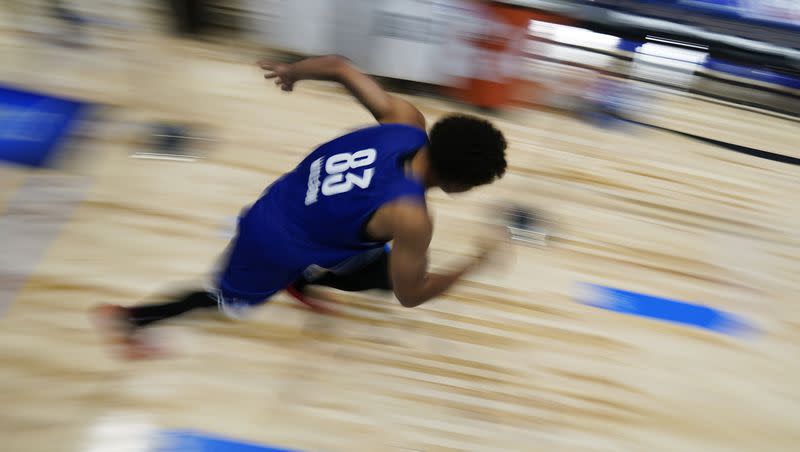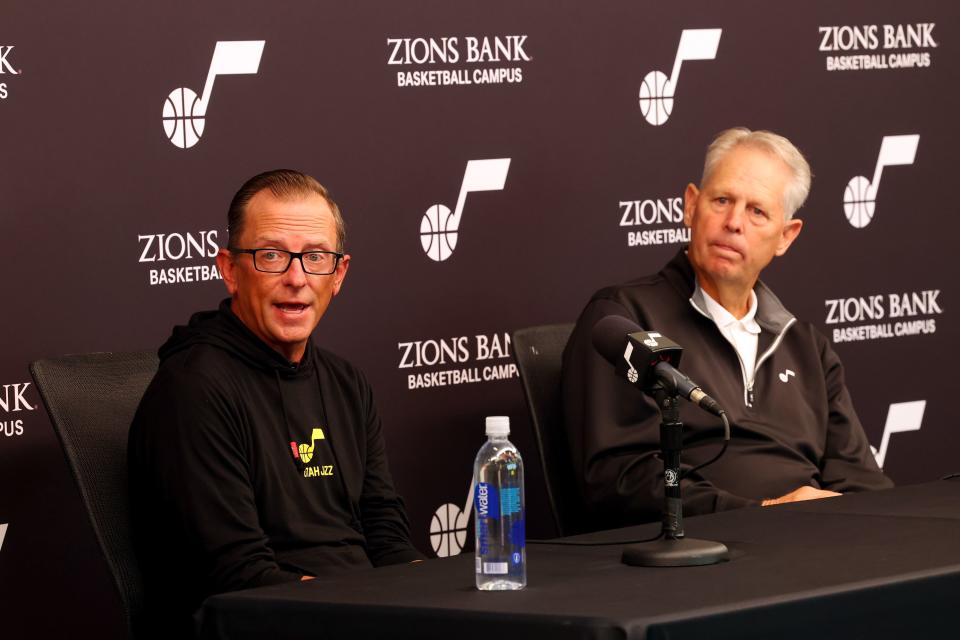
For the last week the NBA world — executives, coaches, scouts, agents and team psychologists — made their way to Chicago for the draft lottery and combine.
“More than anything I want them to feel comfortable. We don’t want them on edge, because we’re trying to get a real sense of who they are.” — Utah Jazz GM Justin Zanik
While there are many on the outside that view the Windy City events as the final stage in the draft prep process, for those involved, it is merely the beginning of the final stage.
“Now the real fun begins,” Utah Jazz general manager Justin Zanik told the Deseret News. “We’ve been working on this for more than a year and we’re going to continue the work. We’ll get a chance to get in front of some of these guys here (at the combine) but this isn’t the end. We’ll bring a lot of guys in for workouts and there are still pro days and there’s more to come before draft night.”
More to come
The Jazz took a huge group to Chicago that included Zanik, CEO Danny Ainge, associate general manager David Fizdale, vice president of player wellness Dr. Ronald Kimmons, vice president of player personnel Bart Taylor, vice president of basketball strategy Steven Schwartz and senior director of basketball intelligence Chuck Terrell.
Many in that group will travel to Los Angeles this week, where many of the top prospects will take part in pro day workouts. In early June the Jazz will be represented in Italy at the Adidas Eurocamp, which highlights some of the most highly touted European prospects. Before, in between and after those showcases the Jazz will be bringing prospects to Utah to work out in person and conduct even more extensive interviews.
While the interviews at the draft combine are helpful, teams are only allowed roughly 25 minutes with each player they meet and everything is rigidly structured by the NBA. When the young players go to Zions Bank Basketball Campus, it allows the Jazz brass to spend more time with them and put them at ease.
Related
“More than anything I want them to feel comfortable,” Zanik said. “We don’t want them on edge, because we’re trying to get a real sense of who they are.”
That’s the goal of the Jazz over the next month. They’ve already watched all the films and they know the skill level and talent and strengths and weaknesses of the draft prospects better than some of them know themselves. Now, it’s about using the time before the June 22 draft to find out who would work on the team and who would be a fit on Will Hardy’s roster.
Evaluating young talent
As the Jazz work towards a smaller list of players they would be interested in drafting, they are doing so while trying to be as realistic as possible.
Ainge is quick to point out the age of the majority of prospective players. Many are 18, 19, 20 years old and, truth be told, you can have all the preconceived notions in the world about a player and they might not end up being the type of player you think they will.
So, instead of thinking about players in terms of expectations or ceilings, Ainge prefers to approach each player with an understanding of realistic potential.
“You can’t expect every one of them to improve,” Ainge said. “But, you can look at what tools they have and how those translate to the NBA.”
The idea guiding these principles is that if you go into every player acquisition hoping that they will become an All-Star and be the piece that changes the course of the franchise, you’re going to more often than not come away feeling disappointed.
The other side of that coin is that there are plenty of players who are drafted late or not drafted at all who become integral players and sometimes even superstars.
Related
“Look at (Nikola) Jokic, he was drafted in the second round. He was the 41st pick in the draft,” Hardy said. “I’ve been in a position where we’ve drafted at 27, 28, 29 and we’ve gotten really good players. Walker (Kessler) was the 22nd pick. There are so many examples of guys that are good and great players that don’t go No. 1.”
That’s why the interviews are an important part of the draft process. Drive, determination, personality and work ethic are all important parts of evaluating young players and trying to figure out how much potential they will be able to tap into.
Endless possibilities
The Jazz currently have the ninth, 16th and 28th overall picks in the NBA draft. They could very well make those selections on draft night, but they could also end up doing something completely different.
“The good thing about the combine is that everyone is in one place,” Zanik said. “From a front-office perspective, it makes conversations really easy and it’s rare that we are all in one place at the same time. But conversations will continue after we all leave here and they’ll continue until the last moments on draft night.”
The Jazz brass are keeping their options open and their thoughts close to the vest.
Could they move up in the draft? Definitely. They have the assets and capital to do so. Could they package picks for an already established player? Absolutely. Everything is on the table. That’s the beauty of where the Jazz are. They have the flexibility and the assets that are going to make them a part of any big conversation this offseason, and every piece of the offseason is connected.
“The draft, free agency, trades, they’re all connected,” Zanik said. “There’s a plan going into it, but there’s also the ability to adapt depending on what becomes available.”
The Jazz have positioned themselves to be ready to adapt to every possible scenario and now that the lottery is over and the combine has concluded, they’re at the beginning of the end. Then, they’ll do it all over again and start preparing for the 2024 offseason.
